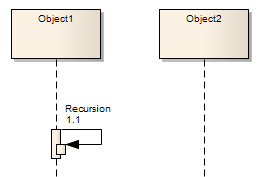
Source and Target of the Mes- sage are not connected to any Lifeline. Once the process has been completed, the following transformation message will open: Removed element : Invalid Message. If the head of a Message is connected to an endpoint, but the tail is connected to anything other than a Lifeline line, the Message will be removed. For example, if the tail of a Sequence Message is connected to an endpoint, the Message will be removed. Once the process has been completed, the following transformation message will open: Removed element : EndPoint.Ī Message whose head connected to a Lifeline line and tail connected to an Endpoint will be transformed into a Found Message.Īnything else connected to an endpoint will also be removed, except the head of a Sequence Message. The Endpoint element itself will be removed. EndpointsĪ Sequence Message whose head connected to an Endpoint and tail connected to a Lifeline line in EA will be transformed into a Lost Message. If the tail of a Message is connected to a Gate, but the head is connected to anything other than a Lifeline line, the Message will be removed. For example, if the head of a Sequence Message is connected to a Gate, the Message will be removed. Gate (EA) and Direction of Diagonal Message (MagicDraw, CEA, or CSM).Īnything else connected to a Gate will also be removed, except the tail of a Sequence Message. The Diagonal Message and Reply Message will be connected to the nearest diagram boundary. Gate (EA) and Reply Message (MagicDraw, CEA, or CSM). Once the Gate has been removed and the transformation process has been completed, the following transformation message will open: Removed element : uml:Gate.Ī Sequence Message whose head is connected to a Gate and tail connected to a Lifeline line in EA will be transformed into a Reply Message with its tail connected to one of the boundary lines of the diagram in which it is contained. A Composite Structure diagram provides one convenient way to create a Class, Part, or Port.Ī Sequence Message whose tail is connected to a Gate and head connected to a Lifeline in EA will be transformed into a Sequence Message with its tail connected to one of the boundary lines of the diagram in which it is contained. They will be bundled according to their relationships. When represented as Lifelines, Classes, Parts, and Ports have different characteristics from the others. They will be arranged in order depending on the position of their Lifeline lines. If this is the case, every component nested within the Lifeline and the Lifeline itself will be drawn separately. Lifelines ArrangementĪ Lifeline can be nested within another component, such as a Part or Port. The length of the gap between the Lifelines will be fixed.

MagicDraw, CEA, or CSM will place the first Lifeline on the left-hand side of the diagram and the second Lifeline on the right-hand side next to the first one. Every Lifeline will be given a fixed value and position in MagicDraw, CEA, or CSM. The position and width of any Lifeline created in EA will not be imported. Fragments can also be added to represent control structures that operate on a group of messages.All of the EA Lifelines will be imported, but a part or port within a Lifeline will be transformed into a new separate Lifeline. The order of objects and messages can be altered to make the diagram more readable and notes can be used to explain parts of the diagram. The choice will depend on what the modeler wants to represent. The elements that appear in Sequence diagrams can be either Classifiers such as Classes and Components or instances such as Objects and Component Instances. Sequence diagrams can also be created automatically from stack traces as a way of visualizing how a system functions. They are particularly useful when used to describe complex protocols or subsystem interactions that are difficult to understand unless presented graphically.

They are more typically used by technical modelers to depict how messages are passed between application components and interfaces to achieve an outcome.

The Sequence diagram can be used to model any set of messages that flow between two or more elements to produce a result. Ribbon: Design > Diagram > Add > UML Behavioral > Sequenceīrowser window Toolbar : New Diagram icon > UML Behavioral > Sequenceīrowser window context menu | Add Diagram.


 0 kommentar(er)
0 kommentar(er)
